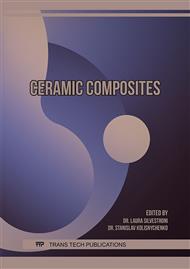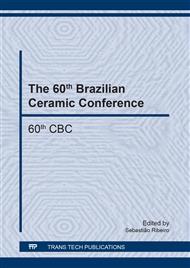p.97
p.102
p.106
p.112
p.118
p.124
p.130
p.136
p.141
Characterization of Al2O3-Al2TiO2 Ceramic Composites: Effects of Sintering Parameters on the Properties
Abstract:
This study aims to evaluate the effects of sintering parameters in crystalline phases, microstructure and mechanical properties of composites obtained through the Al2O3-TiO2 ceramic system. Cylindrical specimens, containing molar ratio of 3 Al2O3: 1 TiO2, were uniaxially pressed at 100 MPa. The applied sintering parameters were varied in five distinct temperature ranges (1300°C, 1400°C, 1500°C, 1575°C or 1600°C) for 2h and 1600°C for 10h. After sintering, samples were characterized by relative density, X-ray diffraction, scanning electron microscopy and mechanical properties (hardness and fracture toughness). After sintering the results point to a microstructure with grains near to 2.5mm, independent of the present phases and crystalline phases composed of: Al2O3 rhombohedral, TiO2 tetragonal e Al2TiO5 orthorhombic. The specimens sintered at 1600°C-10h feature densification 30% higher them the ones sintered at 1300°C-2h, reaching a density higher than 85% of theoretical density. The composite presents hardness higher than 1000HV and fracture toughness upper than 2.2MPam1/2. The better results for the mechanical properties were found in the composites sintered at 1600°C-10h, that showed a bigger relative density than all analyzed specimens, and only phases of Al2O3 and Al2TiO5 could be found, what means that all TiO2 was consumed in the sintering of the new composite.
Info:
Periodical:
Pages:
118-123
Citation:
Online since:
January 2018
Keywords:
Price:
Сopyright:
© 2018 Trans Tech Publications Ltd. All Rights Reserved
Share:
Citation:



